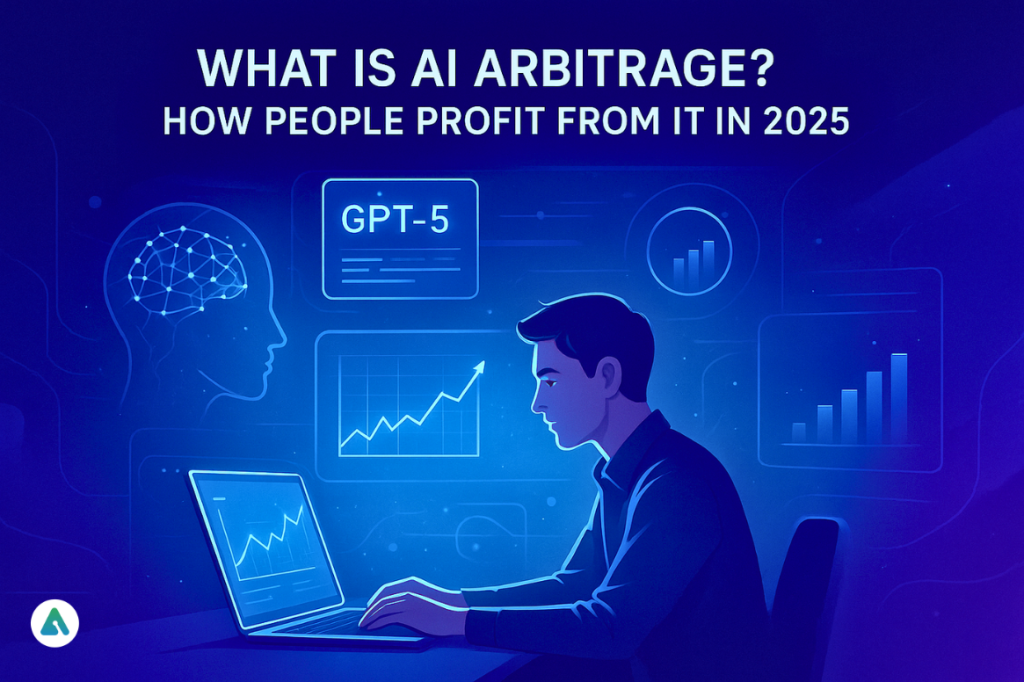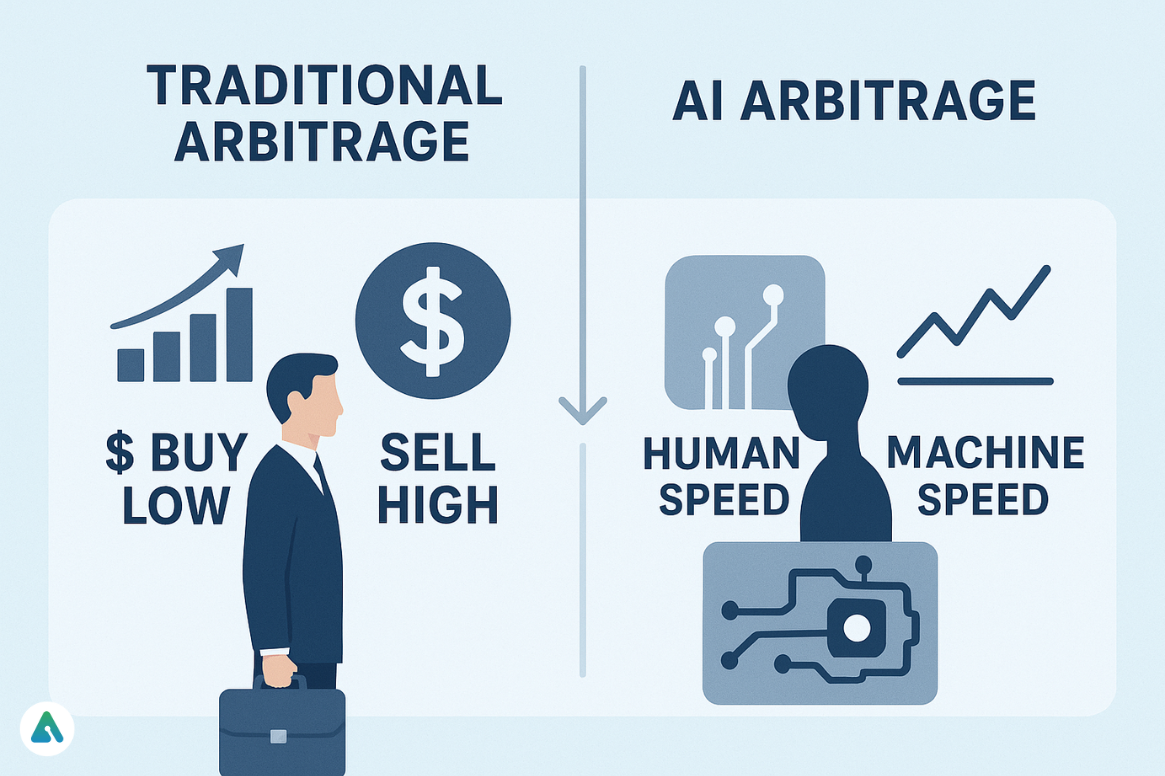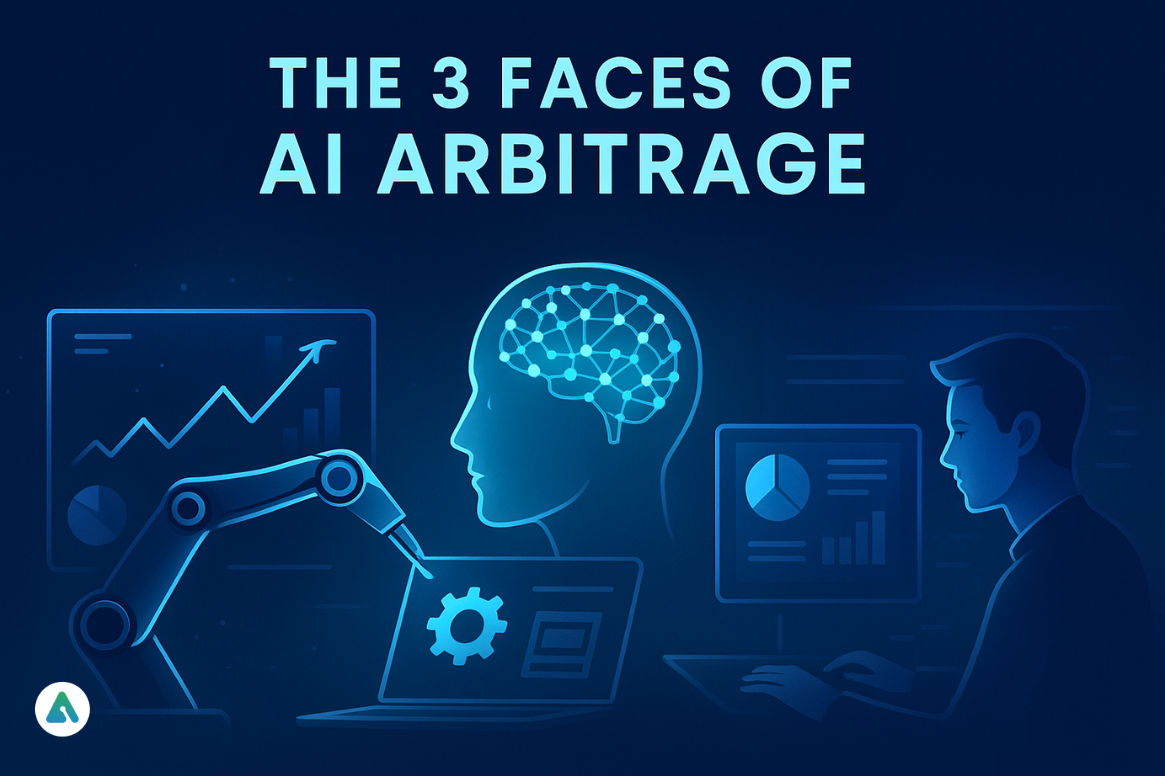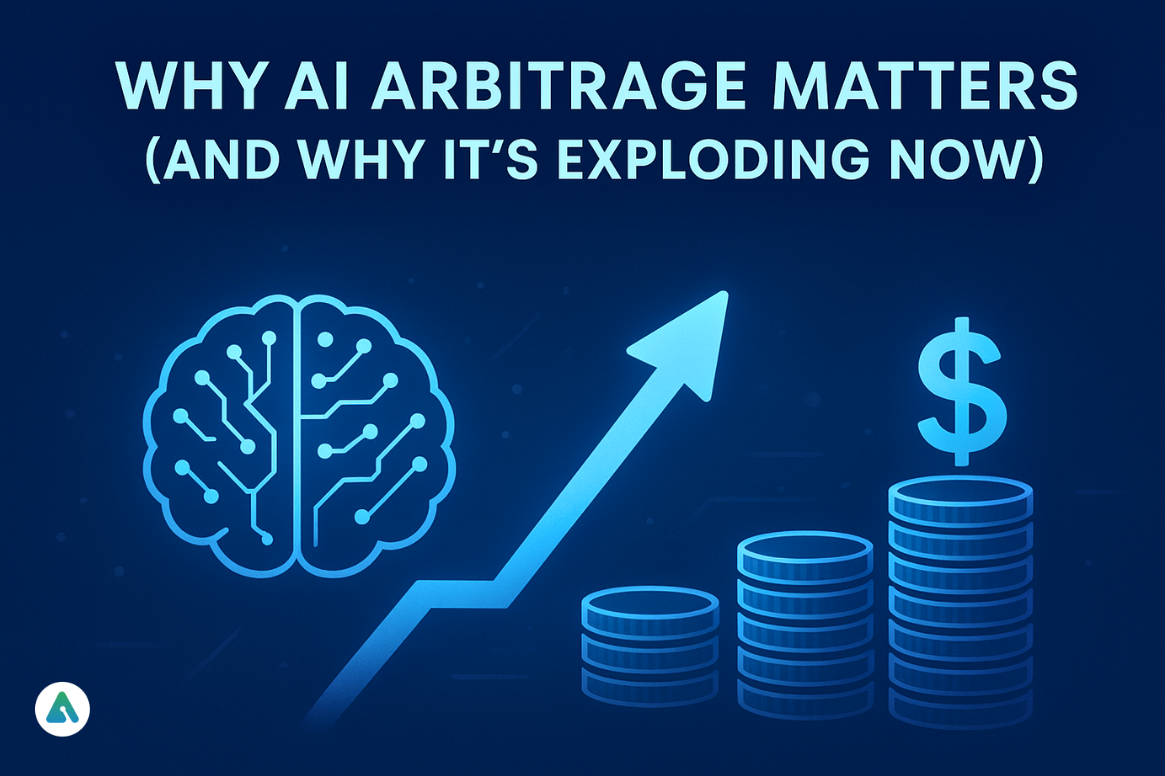While the world debates whether AI will take jobs, a growing group of digital entrepreneurs has found a smarter question:
“How can we make AI work for us — even while we sleep?”
That question lies at the heart of AI arbitrage, a rising phenomenon quietly transforming how individuals, startups, and even trading firms generate value in the digital economy.
Imagine this: while you’re sipping your morning coffee, an algorithm is scanning global markets, finding micro-inefficiencies — fractions of a cent or seconds of timing — and flipping them into profit.
Or picture a solopreneur using GPT-5, Midjourney, and Zapier to build an entire ad campaign before lunch — and selling it at agency prices.
That’s AI arbitrage in action.
It’s not science fiction — it’s the strategic monetization of AI’s efficiency.
In this guide, we’ll unpack everything: what AI arbitrage really means, how it works, the tools that power it, how to get started, and how to avoid the scams flooding your feed.
By the end, you’ll understand exactly why this might be one of the smartest — and most misunderstood — AI business models of 2025.
What Exactly Is AI Arbitrage?
To understand AI arbitrage, start with the root concept: arbitrage itself.
In finance, arbitrage means exploiting a price difference between two markets — buying low in one place and selling high in another. Traders have done it for centuries.
AI arbitrage borrows the same principle — but replaces price gaps with intelligence gaps.
Instead of currencies or commodities, we’re trading efficiency — time, data, and automation.
The “spread” you profit from isn’t the dollar difference between two exchanges, but the performance gap between human speed and machine speed.
In simpler terms, AI arbitrage is about using artificial intelligence to do something faster, cheaper, or smarter — and capturing the value difference.
It’s not about building new AI models.
It’s about leveraging existing AI more strategically than others.
Here’s how that plays out in real life:
- A marketing agency uses GPT-5 and Midjourney to generate entire campaigns overnight, cutting production time by 90% — but charging the same premium.
- A crypto trader runs AI bots that monitor hundreds of exchanges, buying low on one and selling high on another in seconds.
- A solopreneur automates lead generation, research, and client outreach — scaling their freelance business without hiring anyone.
All of these are examples of AI arbitrage — spotting inefficiencies and monetizing them through automation.
How AI Arbitrage Actually Works
It might sound complex, but the underlying process is surprisingly simple.
Think of it as a digital supply chain of intelligence — where data enters at one end and value emerges at the other.
Here’s the step-by-step breakdown:
- Spot the Opportunity
Identify inefficiencies: pricing gaps, workflow delays, or human bottlenecks. This could be in finance, content creation, ad buying, or operations. - Collect and Process Data with AI
Tools like GPT-5, Claude, or LangChain process large datasets, analyze trends, and predict profitable outcomes — far faster than humans. - Execute or Automate
Trading bots place orders. Automation tools like Zapier or Make connect platforms. Content AIs generate drafts, visuals, or campaigns. - Human Oversight and Refinement
Humans validate and refine output — ensuring quality, compliance, and creativity. - Optimize and Scale
AI learns from outcomes, continuously improving strategies for better efficiency and ROI.
This isn’t about letting machines take over — it’s about designing symbiotic workflows where humans provide direction, and AI provides precision.
Traditional arbitrage was reactive.
AI arbitrage is predictive. It doesn’t wait for opportunity — it forecasts it.
The 3 Faces of AI Arbitrage
It can take many forms depending on your goals and expertise. Let’s break down the three major types dominating 2025:
1. AI Trading Arbitrage — Where Code Meets Capital
This is the classic version, reborn for the AI age.
In AI trading arbitrage, algorithms monitor hundreds of financial instruments — crypto, forex, commodities — scanning for price discrepancies across exchanges.
Example: Bitcoin is selling for $64,200 on Exchange A and $64,450 on Exchange B.
An AI trading bot instantly buys from A, sells to B, and repeats the process thousands of times a day.
The result? Small but consistent profits at machine speed.
Popular platforms like AlgosOne, Pionex AI, and HaasOnline are built for exactly this.
But unlike old-school arbitrage, today’s systems don’t just follow price differences — they predict them, using neural networks trained on years of market data.
2. AI Arbitrage Agencies — Turning Efficiency into a Service
Not everyone wants to trade. Many entrepreneurs are building AI-powered agencies that resell automation as a service.
These agencies use AI tools to automate marketing, content, or data tasks for clients.
A $50 task completed by AI can be sold as a $500 service — the difference is the arbitrage.
For instance:
- AI generates 50 blog drafts or ad variations in an hour.
- Humans polish and personalize them.
- The agency delivers them as premium creative assets.
This is “efficiency arbitrage” — converting automation into human-facing value.
3. AI Business Arbitrage — The Solopreneur’s Edge
Beyond trading or agencies, it can form the backbone of entire businesses.
E-commerce sellers use AI to identify underpriced products.
Marketers automate ad bidding, SEO research, or influencer outreach.
Consultants use AI to provide analytics faster than enterprise teams.
This is the democratization of leverage — small players using AI to perform at enterprise scale.
Bonus Concept: AI Model Arbitrage
A fast-emerging form of AI arbitrage in 2025 is AI model arbitrage — the art of routing tasks to the most cost-effective AI model without sacrificing quality.
Instead of relying solely on premium models like GPT-5 for every process, smart entrepreneurs are using lighter, open-source models such as Llama 3 or Mistral for simpler tasks like text classification, summarization, or data tagging.
The savings in API cost per token can translate directly into higher profit margins — especially when scaled across thousands of automated actions.
In essence, model arbitrage isn’t about trading financial assets — it’s about trading intelligence efficiently, optimizing which brain does which job for maximum ROI.
The Tools Powering AI Arbitrage in 2025
Every successful AI arbitrage system is built on a smart stack — a set of interconnected tools that handle intelligence, automation, and execution.
| Layer | Tool Examples | Purpose |
| Intelligence | GPT-5, Claude 3, Gemini | Generate text, code, or insights |
| Automation | Zapier, Make, AgentOps | Connect platforms and trigger actions |
| Data Analysis | LangChain, Pandas AI | Process and reason over structured data |
| Visual Creation | Midjourney, Ideogram | Produce marketing visuals or design assets |
| Trading Execution | AlgosOne, HaasOnline | Automate market arbitrage strategies |
| Analytics & Dashboards | Notion AI, Power BI | Track, measure, and optimize results |
These tools act like an orchestra — each performing one function, but together creating a self-optimizing system that identifies, acts on, and learns from opportunities.
The secret isn’t which tools you use — it’s how you stack and sync them.
The Risks and Realities Behind the Buzz
Where money moves fast, scams follow faster — and it is no exception.
Main Red Flags:
Fake “AI Arbitrage” Investment Platforms
If you see platforms guaranteeing “2% daily profit,” run. Real arbitrage relies on genuine market inefficiencies — not recruiting new investors.
Market Volatility
AI may be fast, but it’s not omniscient. Sudden swings or black-swan events can still cause losses.
Over-Automation
Even advanced AI can misfire with incomplete data. Human oversight remains essential — especially in finance and branding.
How to Stay Safe
- Stick with transparent, reputable AI tools and agencies.
- Start small and scale gradually.
- Maintain a human review loop in every workflow.
- Treat AI as your co-pilot, not your autopilot.
Why AI Arbitrage Matters (and Why It’s Exploding Now)
The rise of AI arbitrage isn’t random — it’s a natural response to the automation economy.
As AI becomes mainstream, the advantage shifts from creation to connection.
The winners aren’t those building models — they’re the ones linking them intelligently.
Think of AI arbitrage as the integration economy — where creativity, automation, and strategy converge.
For digital entrepreneurs, it’s new leverage — turning workflows into income streams.
For traditional businesses, it’s a survival strategy: adapt automation intelligently or get left behind.
How to Start Your Own AI Arbitrage Journey
You don’t need coding skills or big capital — just the ability to spot patterns where AI creates leverage.
Your Roadmap:
- Study the Landscape — Learn what arbitrage means and how AI enhances it.
- Pick a Model — Trading, agency, or workflow automation.
- Choose a Niche — Finance, content, or e-commerce.
- Build Your Stack — Combine 3–5 tools that work in sync (e.g., GPT-5 + Midjourney + Zapier + LangChain).
- Start Small — Test one loop, refine it, and measure results.
- Scale Smartly — Once consistent, productize or automate the system.
Every major AI arbitrage success began with one small, automated loop that worked — then scaled.
The Future of AI Arbitrage
Analysts at Ascendion call AI arbitrage “the next frontier of value creation.”
The Forbes Tech Council predicts the real winners of the AI boom will be “the integrators — not the model builders.”
That’s what AI arbitrage represents: a shift from building intelligence to orchestrating it.
In 2025 and beyond, it’s not the engineers who win — it’s the orchestrators.
Imagine a business that runs 24/7, guided by algorithms you designed once — your “team” being an invisible web of connected AI tools.
That’s the promise — and power — of AI arbitrage.
FAQs
Q: What is AI arbitrage?
AI arbitrage is the practice of using artificial intelligence and automation to perform tasks faster, cheaper, or smarter than traditional methods — and profiting from the difference.
Q: How does AI arbitrage work?
It connects multiple AI tools (like GPT-5, Midjourney, and Zapier) to identify, act on, and automate profitable opportunities — from trading to business workflows.
Q: Is AI arbitrage legal?
Yes, when done transparently and ethically. Avoid investment schemes promising guaranteed profits.
Q: What are the risks?
Market volatility, unreliable bots, and scams posing as arbitrage platforms. Always verify tools and start small.
Q: What tools are best for AI arbitrage?
GPT-5, Claude, LangChain, Zapier, Midjourney, and AlgosOne are among the most widely used in 2025.
Final Thoughts: The Smartest Arbitrage Is Still Human
This workflow might sound futuristic, but its logic is timeless:
Find the gap. Close the gap. Capture the value.
Yes, AI gives you speed, precision, and scale.
But the true arbitrage — the one no algorithm can replicate — is still human judgment.
It’s the human who knows which inefficiency to solve, which workflow to automate, and when to intervene.
So if you’re worried about being replaced by AI, don’t.
Start learning how to arbitrage it.
Because the smartest play in 2025 isn’t competing with machines — it’s mastering how to make them work for you.
Visit: AIInsightsNews





